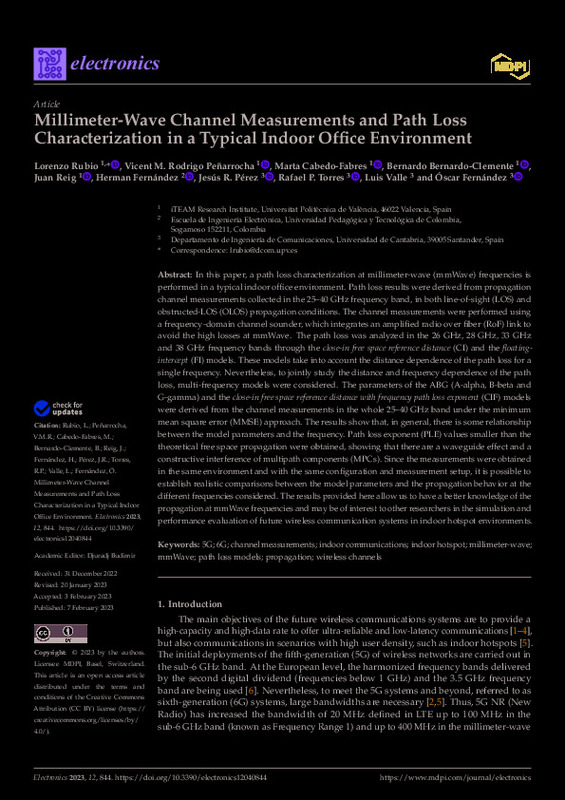JavaScript is disabled for your browser. Some features of this site may not work without it.
Buscar en RiuNet
Listar
Mi cuenta
Estadísticas
Ayuda RiuNet
Admin. UPV
Millimeter-Wave Channel Measurements and Path Loss Characterization in a Typical Indoor Office Environment
Mostrar el registro sencillo del ítem
Ficheros en el ítem
| dc.contributor.author | Rubio Arjona, Lorenzo
|
es_ES |
| dc.contributor.author | Rodrigo Peñarrocha, Vicent Miquel
|
es_ES |
| dc.contributor.author | Cabedo Fabres, Marta
|
es_ES |
| dc.contributor.author | Bernardo-Clemente, Bernardo
|
es_ES |
| dc.contributor.author | Reig, Juan
|
es_ES |
| dc.contributor.author | Fernández, Herman
|
es_ES |
| dc.contributor.author | Pérez, Jesús R.
|
es_ES |
| dc.contributor.author | Torres, Rafael P.
|
es_ES |
| dc.contributor.author | Valle, Luis
|
es_ES |
| dc.contributor.author | Fernández, Óscar
|
es_ES |
| dc.date.accessioned | 2024-05-02T18:08:32Z | |
| dc.date.available | 2024-05-02T18:08:32Z | |
| dc.date.issued | 2023-02 | es_ES |
| dc.identifier.uri | http://hdl.handle.net/10251/203932 | |
| dc.description.abstract | [EN] In this paper, a path loss characterization at millimeter-wave (mmWave) frequencies is performed in a typical indoor office environment. Path loss results were derived from propagation channel measurements collected in the 25¿40 GHz frequency band, in both line-of-sight (LOS) and obstructed-LOS (OLOS) propagation conditions. The channel measurements were performed using a frequency-domain channel sounder, which integrates an amplified radio over fiber (RoF) link to avoid the high losses at mmWave. The path loss was analyzed in the 26 GHz, 28 GHz, 33 GHz and 38 GHz frequency bands through the close-in free space reference distance (CI) and the floating-intercept (FI) models. These models take into account the distance dependence of the path loss for a single frequency. Nevertheless, to jointly study the distance and frequency dependence of the path loss, multi-frequency models were considered. The parameters of the ABG (A-alpha, B-beta and G-gamma) and the close-in free space reference distance with frequency path loss exponent (CIF) models were derived from the channel measurements in the whole 25¿40 GHz band under the minimum mean square error (MMSE) approach. The results show that, in general, there is some relationship between the model parameters and the frequency. Path loss exponent (PLE) values smaller than the theoretical free space propagation were obtained, showing that there are a waveguide effect and a constructive interference of multipath components (MPCs). Since the measurements were obtained in the same environment and with the same configuration and measurement setup, it is possible to establish realistic comparisons between the model parameters and the propagation behavior at the different frequencies considered. The results provided here allow us to have a better knowledge of the propagation at mmWave frequencies and may be of interest to other researchers in the simulation and performance evaluation of future wireless communication systems in indoor hotspot environments. | es_ES |
| dc.description.sponsorship | This work has been funded in part by the MCIN/AEI/10.13039/501100011033/ through the I+D+i Project under Grant PID2020-119173RB-C21 and Grant PID2020-119173RB-C22, and by COLCIENCIAS in Colombia. | es_ES |
| dc.language | Inglés | es_ES |
| dc.publisher | MDPI AG | es_ES |
| dc.relation.ispartof | Electronics | es_ES |
| dc.rights | Reconocimiento (by) | es_ES |
| dc.subject | 5G | es_ES |
| dc.subject | 6G | es_ES |
| dc.subject | Channel measurements | es_ES |
| dc.subject | Indoor communications | es_ES |
| dc.subject | Indoor hotspot | es_ES |
| dc.subject | Millimeter-wave | es_ES |
| dc.subject | MmWave | es_ES |
| dc.subject | Path loss models | es_ES |
| dc.subject | Propagation | es_ES |
| dc.subject | Wireless channels | es_ES |
| dc.subject.classification | TEORÍA DE LA SEÑAL Y COMUNICACIONES | es_ES |
| dc.title | Millimeter-Wave Channel Measurements and Path Loss Characterization in a Typical Indoor Office Environment | es_ES |
| dc.type | Artículo | es_ES |
| dc.identifier.doi | 10.3390/electronics12040844 | es_ES |
| dc.relation.projectID | info:eu-repo/grantAgreement/AEI/Plan Estatal de Investigación Científica y Técnica y de Innovación 2017-2020/PID2020-119173RB-C22/ES/TECNICAS DE MEDIDA Y MODELOS AVANZADOS DE CANAL PARA LA DEFINICION DE LOS FUTUROS SISTEMAS 6G (A6GMODEL-UC)/ | es_ES |
| dc.relation.projectID | info:eu-repo/grantAgreement/MICINN//PID2020-119173RB-C21//TECNICAS DE MEDIDA Y MODELOS AVANZADOS DE CANAL PARA LA DEFINICION DE LOS FUTUROS SISTEMAS 6G (A6GMODEL-UPV)/ | es_ES |
| dc.rights.accessRights | Abierto | es_ES |
| dc.contributor.affiliation | Universitat Politècnica de València. Escuela Técnica Superior de Ingenieros de Telecomunicación - Escola Tècnica Superior d'Enginyers de Telecomunicació | es_ES |
| dc.description.bibliographicCitation | Rubio Arjona, L.; Rodrigo Peñarrocha, VM.; Cabedo Fabres, M.; Bernardo-Clemente, B.; Reig, J.; Fernández, H.; Pérez, JR.... (2023). Millimeter-Wave Channel Measurements and Path Loss Characterization in a Typical Indoor Office Environment. Electronics. 12(4). https://doi.org/10.3390/electronics12040844 | es_ES |
| dc.description.accrualMethod | S | es_ES |
| dc.relation.publisherversion | https://doi.org/10.3390/electronics12040844 | es_ES |
| dc.type.version | info:eu-repo/semantics/publishedVersion | es_ES |
| dc.description.volume | 12 | es_ES |
| dc.description.issue | 4 | es_ES |
| dc.identifier.eissn | 2079-9292 | es_ES |
| dc.relation.pasarela | S\487277 | es_ES |
| dc.contributor.funder | Ministerio de Ciencia e Innovación | es_ES |
| dc.contributor.funder | Departamento Administrativo de Ciencia, Tecnología e Innovación, Colombia | es_ES |








